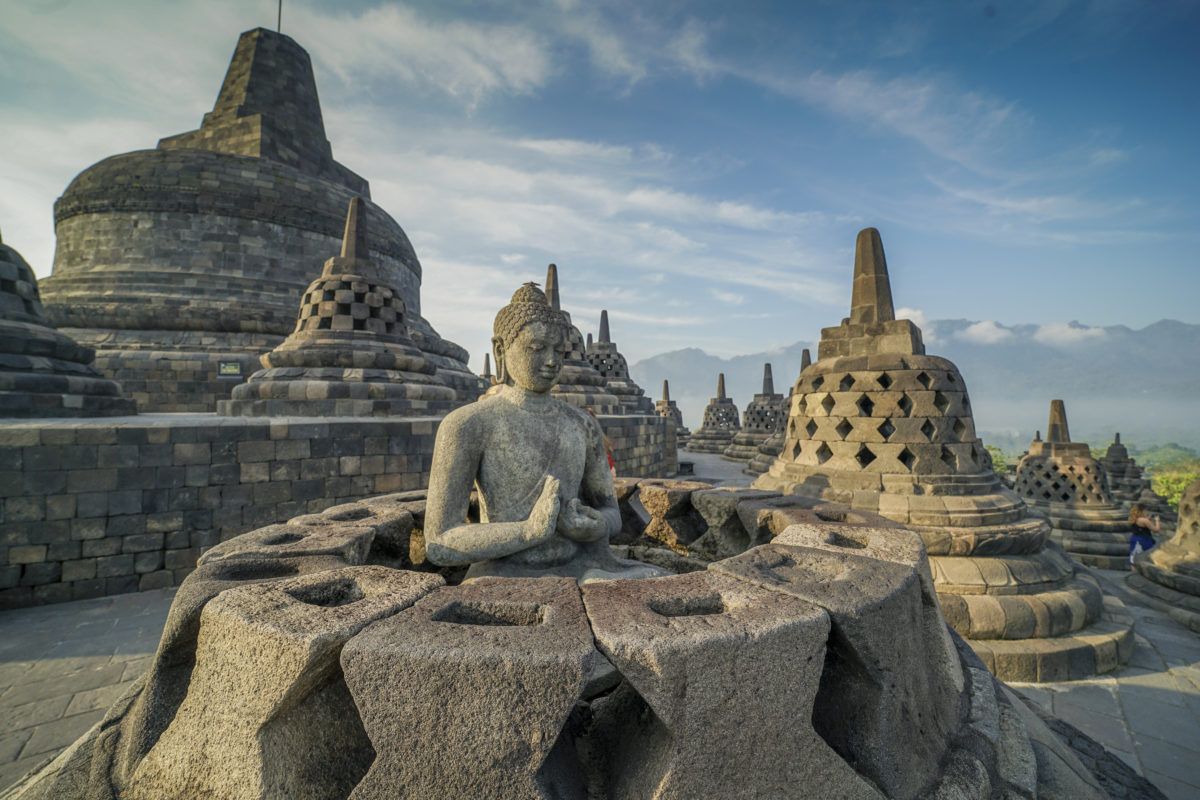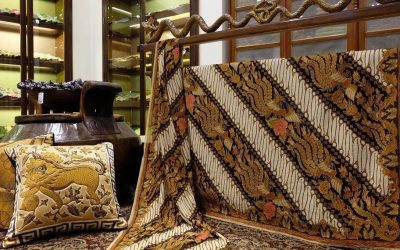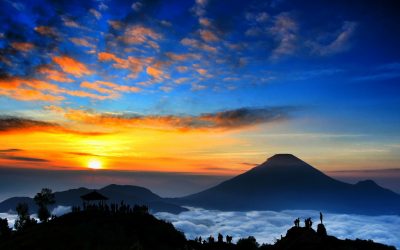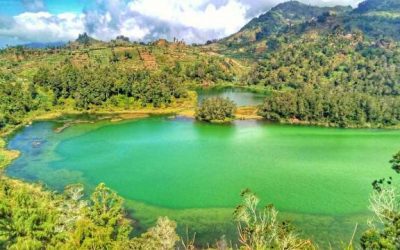Home / Batik Regions – Western Indonesia – Java Island – Central Java / The Borobudur Temple – UNESCO World Heritage Site
Cultural Destination
Embrace the spirit of the place!
The Borobudur Temple – UNESCO World Heritage Site

Borobudur Temple Compounds, the UNESCO World Heritage Site (photo: Borobudur Park)
The Borobudur Temple
Famous destination among tourists all over the world, the Borobudur Temple is the biggest Buddhist temple In the world and is inscribed as UNESCO World Heritage Sites in 1991. It has a unique architectural style that reflects Buddhist spiritual values and principles. Surrounded by green hills and lakes, this temple is also situated in a specific location in accordance with astronomical coordinates invented in ancient time. Thanks to this outstanding position, Borobudur temple was appointed as the venue of International Astronomy Olympiad in 2015. The name of “Borobudur” was derived from the Sanskrit words “Vihara Buddah Uhr”, which means the Buddhist Monastery on the hill.
Destinasi Wisata di Jawa Tengah
Danar Hadi Batik Museum
Do you want to travel the time through Batik? One of the must visit destination in Central Java is
Golden Sunrise in Dieng Plateau
Dieng Plateau mountain complex is a magic place to experience two different kinds of sunrise, which are
Telaga Warna Lake in Dieng
Telaga Warna or Color Lake is a unique natural phenomena of lake whose colors change frequently. The lake contains high
Central Java
Batik Motifs
Parang Seling
Parang Seling or “alternating daggers” is a royal batik motif. It is a feminine variant of
Sido Mulyo
Sidomulyo is one of the classical motifs, which is specifically used for the bride’s costume in
Gurdo Solo
Gurdo or garuda bird is the mount of the Indian god Vishnu. As the Sun Bird,
Discover
Indonesian
Batik
Motifs
Daun Lada Hitam
The black pepper motif represents the main commodity of Bangka Belitung
Taiganja
Taiganja is a precious gold pendant that shows the social status of the Kaili family. It is
Leuit Sijimat
This motif reflects the daily activities of the Baduy tribe in Banten. The main ornaments of batik motif consist of:
Daun Simpor
This motif is inspired by the Simpor plant (Dillenia Suffruticosa) which is a typical
Tangerang Herang
Tangerang Herang motif is a symbol of Tangerang city. The Tangerang Herang batik motif consists of
Dayak Taghol
Dayak Taghol has a distinctive style of four curved lines and small dots. This motif represents
Rangkiang
The word “Rangkiang” refers to the rice granary in the Minangkabau language. It symbolizes
Gigi Haruan Lidi
The Gigi Haruan Lidi motif is taken from the name of the cork fish and is a symbol of
Durian Pecah
Broken Durian motifs depict the foundation of faith. The second half signifies the mastery of
Lok Baintan Floating Market
As you can imagine, the most authentic thing is that you can buy things and even
Ake Patra
Ake is related to the divinity and the composition of the universe. It is a symbol of
Pinawetengan
The Pinawetengan Batik pattern was taken from a prehistoric inscription in
Salakanagara
Salakanagara batik motif illustrates the first kingdom in the Betawi land
Besurek Rembulan
This batik illustrates praise for God who created the wonderful universe
Insang Ikan
Insang refers to the gills of the fish. This is a typical pattern of Malay ethnic who inhabits
Sekomandi
Its philosophical meaning is the eternal union which refers to a saying “until death do us part”
Merak Ngeram
The hatching peacock motif has a very deep meaning which refers to the sacrifice and
Tifa Totobuang
The batik motifs illustrate Maluku’s traditional music instrument called
Gajah Way Kambas
The motif illustrates the Lampung’s natural reserve, the Way Kambas. it also symbolizes
Srimanganti
The name of the Srimanganti motif is derived from Palace’s hallway that connects to
Manguni Minahasa
Manguni is identified as the symbol of the Minahasa people. Manguni is known as a
Karawo Mahkuta
Mahkuta refers to Gorontalo’s traditional crown. It represents noble characters of
Wakatobi
It symbolizes the coastal beauty of the Wakatobi island and the symbol of Patra symbolizes
Lipaq Sabe
Lipaq Saqbe contains a simple geometric classical motif with various flower decorations. This textile is
Rumah Mamuju
the Batik motif illustrates the house of Mamuju King with the stairs, located on the left of the wooden stage house
Keluak Daun Pakis
The word “Keluak” is a Minang language which means twisted or tangled. The Motif of
Malinau Cultural Festival
You will witness a unique competition that might not be found other than in
Kain Cual
Cual textile tradition has existed since the 17th century. The word “Cual” refers to
Gurdo Solo
Gurdo or garuda bird is the mount of the Indian god Vishnu. As the Sun Bird,
Gorga Simeol-Meol
The Gorga Simeol-meol is a pattern of plant tendrils. it is regarded as a symbol of longevity and
Ikan tambal
The word “Ikan” refers to fish. The philosophical meaning of Ikan Tambal means is
Cengkeh
The clove flower motif is the main commodity of the Tolitoli Regency. This motif represents
Gumin Tambun
Based on Hindu mythology, this motif symbolizes lucks, abundant wealth, and
Honai
The Honai is inspired by the traditional house of the Papuan community living in
Tanah Liek
The word “Tanah Liek” refers to clay in Minang language. It is also known as
Dayak Kamang
Kamang motif is generally found in the Dayak tribe shield because it is believed to
Daun Sirih
This motif illustrates betel leaves that are used by Lombok communities as traditional
Tenun Bima
The motifs are adopted from Bima woven textile. This pattern has received a great
Enggang Dayak
Local people beliefs that hornbills are an incarnation of the Commander of the Birds. It has supernatural
Sido Mulyo
Sidomulyo is one of the classical motifs, which is specifically used for the bride’s costume in
Sandeq
Sandeq Boat is a symbol of the maritime importance of the West Sulawesi region. The greatness of
Pati-Pati Pinehiku
It symbolizes the hierarchy in society and the social status of the Mekongga
Tampuk Manggis Sasirangan
The motif illustrates the philosophy of the mangosteen fruit, which is
Burung Bidadari
Bidadari birds are endemic birds in Halmahera. This motif represents an
Hiu Taliyasan
Indonesia is also home to the world’s largest fish, the whale shark (Rhincodon typus). Hiu Taliyasan refers to
Paqbarre Allo
The word “Barre” means round and “Allo” means the sunlight. This motif is interpreted as
Gonggong Siput
Gonggong (Strombus Turturella) is one type of sea snail found around
Bintik Tujuh
The Bintik Tujuh (Seven Dots) motif has 7 white spots and green color gradation as
Sero Tangga
The Sero Tangga illustrates an endearing feeling and sacrifices of a person to fulfil
Tikar Natuna
The Tikar Natuna motif is adapted from the traditional making of pandanus mats in
Pala Salawaku
This motif illustrates the unique weapons of the Maluku region, namely
Gamolan
This motif illustrates Gamolan, a bamboo musical instrument of Lampung that is
Kasih Tak Sampai
‘Kasih Tak Sampai’ is an idiom in the Indonesian language which refers to
Bale Lumbu
This motif signifies the welfare of the ancient Sasak society. Bale also symbolizes the
Kaharingan
The Kaharingan or ‘tree of life’ based on the Dayak tribes’ belief system. This tree symbolizes
Bomba Mawar
This motif means sacred love for family, kingdom, and God; It also illustrates
Kuda Kupang
Horses symbolize wealth. It contains noble values of virtuous characters that bring
Ukir Sentani
The Ukir motif is a batik motif that is inspired by various traditional Sentani wood carvings
Awan Berarak
Awan Berarak is a combination of Dayak motifs and Malay patterns. The word ‘Awan Berarak’ means the
Tabir Tanjung
Tanjung flower is a type of Cherry tree flower, which is commonly found in
Raja Ampat
Raja Ampat motif represents the marine life at Raja Ampat archipelago in
Gedhog Kembang Waluh
a combination of Javanese cultural motif of the Majapahit kingdom (XII-XIV century) with
Karawo Pinang
Pinang refers to the Palm areca tree. This motif is considered as the original
Kerawang Tegak Aceh
The Vertical Upright (Kerawang Tegak) Motif symbolizes a person who has a strong
Buketan Bali
The Balinese bouquet (Buketan Bali) is a floral arrangement and the name is
Besurek Rafflesia
The term “Basurek” refers to a textile that contains letters or inscriptions
Tongkonan
Toraja’s traditional house is called Tongkonan. Tongkonan is a place for
Bekantan Pakis
This motif represents Pakis Haji (Polystichum setiferum), an endemic plant in
Tubo Kelapa
Coconut tree is a symbol of a good character and strong mentality. It illustrates the more success a person, the more
Mahkota Siger
Siger is the crown of a noblewoman in ancient time. It is a symbol of femininity, strength, and
Sekar Jati
Sekar means flower and Jati refers to teak trees that symbolizes a strong mental character that
Angsa Duo
According to legend, the Angso duo batik motif is a pair of swans that are believed to have led Princess
Gonggong Beruntun
This motif illustrates that a person should maintain a positive attitude and



